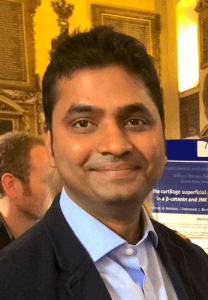Posted By: Sara Cullinan, PhD, Deputy Editor, AJHG
Each month, the editors of The American Journal of Human Genetics interview an author of a recently published paper. This month we check in with Hemanth (@hemanth_tummala) to discuss his recent paper “Germline thymidylate synthase deficiency impacts nucleotide metabolism and causes dyskeratosis congenita”.
SC: What motivated you to start working on this project?

HT: Finding faults within the DNA sequences and learning their associations with disease has always piqued my interest. Our lab studies the genomic basis of complex hematological syndromes and particularly the pathogenic effect of a genetic variant on a molecular mechanism. Dyskeratosis congenita (DC) is one such complex hematological condition caused by variants in genes that disrupt telomere and telomerase function at chromosome ends. DC individuals usually have very short/abnormal telomeres and therefore, telomere length measurement and genetic analysis of the disease genes identified so far have become useful diagnostic tools. However, a significant number of DC individuals from our registry remain uncharacterized at the genetic level and present with short telomeres, hinting at the unknown genes and or mechanisms in causing DC.
SC: What about the papers/project most excites you?
HT: In this paper we report a series of heterozygous LOF and missense variants in thymidylate synthase (TYMS) in a c ohort of pediatric probands with DC features. The initial twist in this study is when the affected probands displayed very low levels of TYMS protein when compared to the parent who also carried the same TYMS variant. Noting that TYMS RNA transcript is expressed to the same level between parents and the affected child, our subsequent molecular and biochemical experiments suggested that there must be another genetic variant(s) that could be segregating from the “wild-type” parent and impact on the overall TYMS level in the affected child.
Over time, we understood that TYMS regulation is very complex and tightly controlled by a combination of SNPs and its neighboring gene ENOSF1 on the same locus. Targeted sequencing of this locus and a series of gene rescue studies have enabled us to establish a digenic epistatic relationship between these two neighboring genes, i.e. TYMS and ENOSF1, which physically overlap on chromosome 18 operate as a functional unit to control thymidylate synthase levels in our cells. The evidence of such a molecular pleiotropy executed by multiple variants in nearby genes defines a novel causal mechanism in DC.
Although some GWAS studies indicated TYMS as a candidate gene for telomere length regulation previously, our study on DC cohorts provided the ultimate proof that severe TYMS deficiency results in phenotypic effect that is consistent with telomere disease biology.
SC: Thinking about the bigger picture, what implications do you see from this work for the larger human genetics community?
HT: The digenic mechanism described in this paper was only possible through a combined genetic and functional approach. Our work suggests similar digenic mechanisms could be responsible for as yet uncharacterized cases of other Mendelian disorders. Furthermore, the TYMS inhibitor 5-flurouracil (5-FU) is widely used as a first line chemotherapeutic drug for various cancers and there is data to suggest SNPs within TYMS and ENOSF1 are associated with severe hypersensitivity to these drugs. I believe these findings therefore provide some biological basis for the severe toxicity (hand-foot-syndrome) observed in a subgroup of cancer cases following treatment with 5-FU.
SC: What advice do you have for trainees/young scientists?
HT: Always choose an important problem and keep updated in relation to new technology. Be an example of talent and motivate others around you. Whether, feeling low or high, do share your thoughts and concerns with people around you. I am lucky to have such peers around me who value my opinions and help to achieve my goals. In academia you are always being judged, so don’t be afraid and keep the thought that you are constantly learning.
SC: And for fun, tell us something about your life outside of the lab.
HT: I really enjoy cooking something that can vary from Indian curries to biryanis or Mediterranean pastabakes to continental Chinese noodles. I love playing cricket at my local club called “Old Minchendenians” in Hertfordshire County and enjoy the traditional teas that comprise of cucumber sandwiches and cupcakes on a typical English summer day, which is a nature’s little joke.
